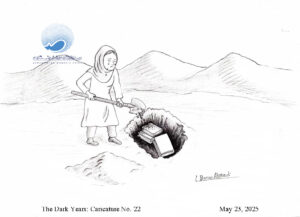Over the past 20 years, in addition to educational opportunities, good career prospects were also created for Afghan Women. An example of this is that the administration in power previous to the Taliban takeover implemented a policy of positive discrimination in order to enhance female recruitment in government positions.
In this policy, 5 points were attributed to female candidates in the examination of civil service positions. The government also tried to attract more women to government offices through various support programs. As a result, the number of working women in Afghanistan reached an unprecedented high level in the country’s history.
According to the Ministry of Labour and Social Affairs, women made up between 24% and 30% of government employees in 2018. At this time, thousands more were working with foreign and domestic private institutions.
Based on data released by the National Statistics Office in 2019, out of the 421,000 personnel in civil service offices, 101,200 were women. There were 1,265 women amongst the 184,000 personnel of the Afghan National Army. another 2000 women served alongside men in the country’s security forces.
In healthcare and in law women were able to hold prominent positions and pursue careers. There were 3,700 female doctors, 260 judges, and 331 female prosecutors working in Afghanistan before the Taliban took control.
If we add the number of women working with foreign and domestic NGOs and private institutions such as universities, schools, banks, and other private companies, the number of working women in Afghanistan in 2019 reached as high as 160,000. These women were either the sole breadwinners for their families or helped their family members in putting food on the table.
Afghanistan had never seen such a high number of working women in its entire history. Having 160,000 female professionals in the workforce was an incredible achievement and success for the country both in terms of tackling gender inequality as well as improving the country’s economy.
However, all the achievements of the last 20 years were lost with the Taliban takeover. Most of the 160000 women that I mentioned either fled the country or went into hiding. Nearly all were forced to leave their job and stay at home.
According to Article 23 of the Universal Declaration of Human Rights, “Everyone regardless of their gender has the right to work and to free choice of employment and be protected against unemployment.” But since the Taliban came to power all women’s rights have been taken away. Women no longer have the right to seek employment and work outside of their homes. The economic impact of preventing women from working will not only be limited to those 160,000 women but will also do irreparable damage to the Afghan economy as a whole.
Since economic phenomena are multi-dimensional, it is necessary to see them from a different angle. When 160,000 individuals are unemployed, the purchasing power of 160,000 families decreases. If we take the average number of individuals in an Afghan family as 6, Then 160,000 x 6= 960,000, nearly 1 million people.
The result of preventing all of these women from working means that the purchasing power of 960,000 individuals in the country will decrease and that 960,000 people will not be able to afford their basic necessities.
As the purchasing power of this number of people decreases, the total demand in the country decreases. Decreased aggregate demand will lead to reduced aggregate supply, leaving the same number of people previously employed in the supply chain unemployed.
If we take into account the immediate consequences of the Taliban’s decision on restricting women from work, almost 2 million people will feel economic pain such as unemployment and reduced purchasing power which then decrease the country’s GDP.
according to the United Nations Development Programme, excluding women from working might immediately cost Afghanistan’s economy up to $1 billion, or 5% of GDP, which will lead to a half a billion-dollar reduction in household consumption.
But in the long run, the crisis will be much deeper and bigger, because the unemployment of every person in the supply chain leads to a reduction in the purchasing power of all their family members. This is a never-ending spiral that will push the country’s economy into crisis.
Therefore, the Taliban’s plan to prevent women from working will create two extremely serious problems. Food poverty for millions of people and paralysis of the economy.









